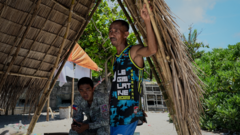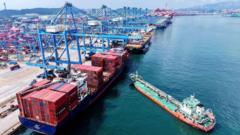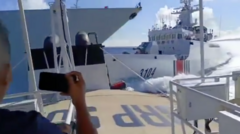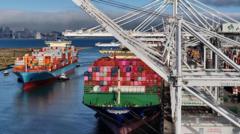Despite its modest size, Pagasa Island, home to around 300 residents, is a critical outpost for the Philippines in the contested South China Sea, as it faces increasing intimidation from Chinese naval forces. Residents have adapted to life under threat while emphasizing the island's strategic importance and calling for continued support from the government.
Small Island, Big Stand: Pagasa’s Defiance Against Chinese Encroachment in the South China Sea

Small Island, Big Stand: Pagasa’s Defiance Against Chinese Encroachment in the South China Sea
Pagasa Island, known as Hope, houses a resilient Filipino community, standing firm amidst significant Chinese maritime tensions in the South China Sea.
Pagasa Island, or "Hope," is taking a stand in the face of Chinese maritime aggression in the South China Sea. This tiny island, measuring just 37 hectares, lies under Philippine control and serves as home to approximately 300 residents living in modest wooden houses. While they fish in the clear waters and cultivate what little they can, they are also surrounded by a substantial fleet of Chinese vessels, including navy, coastguard, and maritime militia boats.
China has broadened its presence in the region over the last decade, seizing submerged reefs, constructing military air bases, and deploying numerous ships to assert dominance over the strategic sea routes. Notably, the Philippines and Vietnam are among the few Southeast Asian nations that have sought to counter China's advances, despite their smaller military capabilities.
The significance of Pagasa Island lies not only in its strategic location, but also in its civilian population, which is uncommon among the numerous disputed territories in the South China Sea. According to Jonathan Malaya, assistant director-general of the Philippines National Security Council, “Pagasa is very important to us.” With an operational runway and a permanent community, it strengthens the Philippines' legal claims over the area.
Travel to Pagasa can be a challenge, typically taking two to three days by boat or just over an hour by plane, both of which face unpredictable weather conditions. Following the runway's recent expansion, larger transport aircraft can now deliver much-needed supplies and personnel, including military support. Current infrastructure improvements include a new hangar, a control tower, and enhancements to the harbor.
Seized from Taiwanese control in 1971, Pagasa was officially annexed by the Philippines in 1978 and has since been a lifeline for those who settled there, reliant on government assistance for monthly provisions. Even though residents have witnessed the arrival of basic utilities like electricity and mobile service, the increasing presence of Chinese ships has hampered their primary source of income: fishing.
Local fisherman Larry Hugo has lived on Pagasa for 16 years and documents the growing Chinese control of the area. He recounts how intimidating encounters with Chinese vessels have restricted his fishing grounds. “Their ships are huge compared to ours,” he notes, explaining how the situation has changed his fishing practices.
Meanwhile, educator Realyn Limbo has experienced the school's growth over her decade of teaching, emphasizing the tranquility and simplicity of island life. However, she acknowledges the challenges of providing medical assistance, especially when transport options are limited due to weather.
Despite its serene environment and picturesque beaches, Pagasa gives off the impression of a community holding its ground against the looming Chinese threat. The tensions are clear as military personnel routinely inform Chinese airbase officials that they are entering Philippine territory.
In contrast to past administrations that sought to avoid confrontation, the current Philippine government is taking a firmer stance against Chinese incursions, sending weekly protests to the Chinese Embassy regarding these perceived territorial violations. This shift in policy illustrates a commitment to asserting sovereignty in a region fraught with tension and uncertainty.


















